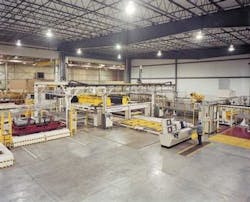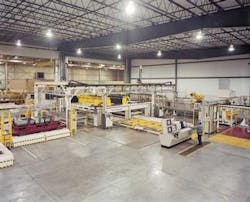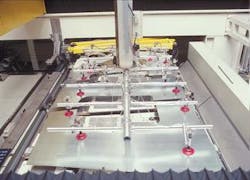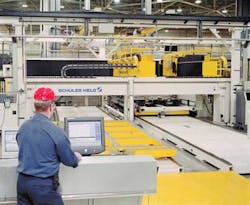Welding multiple thicknesses before stamping
Tailor Steel America (Holt, MI), builds precise, complex, multipiece laser-welded body sides for the automotive industry. It is owned by Sidmar Steel (Ghent, Belgium), itself part of the newly formed Arcelor Steel Group headquartered in Luxembourg. Tailor Steel America, incorporated in 1997, specializes in complex laser-welded sides, supplying auto body sides to General Motors and others.
In its first year of operation at Tailor Steel America (Holt MI), an advanced laser welding system having dual gantries and dual portals has lived up to its design capabilities—it shaved 20 percent off the shop's previous cycle times. The savings may even be greater. For example, the machine accuracy for welding the 4m × 2m auto side panels is so precise that the cycle-time-stealing seam tracker no longer needs to be used.
Tailor Steel took delivery of the laser welding system in early 2002 from Schuler Held Lasertechnik (Canton, MI). This non-linear, dual-head moving optics laser welder is designed around Schuler's modular Pedilas concept. The dual 4m × 2m welding fixtures mounted on two movable tables have a 6m × 4.5m working area. A second machine-encompassing portal contains a gantry robot to perform loading and unloading from above. The machine's two 8kW CO2 Rofin-Sinar (Plymouth, MI) lasers were requested by Tailor Steel to be consistent with those already used in the company's U.S. plants.
Similar to systems previously used in Tailor Steel's European facilities, this unit is an evolution of the European single-gantry machines. The addition of the second gantry and second laser increases throughput significantly. The machine design accommodates simultaneous welding by both bridges on one part, or welding with each bridge on independent parts. As each completed part is unloaded and a new part loaded, welding proceeds on the next part. Overall capacity increases are 90 percent. The Vanlanduyt Company (Wetteren, Belgium) built the fixtures; Alstom/CPA (Wilrijk, Belgium) performed software integration; and IMA (Houthalen, Belgium) built the blank handling equipment. The dual-gantry laser welding system was built and integrated by Schuler Held Lasertechnik, and Arcelor, Tailor Steel America's majority shareholder, performed system integration responsibility.
Since 1997, Tailor Steel has produced laser welded, multipiece tailored blanks—complex auto body sides—as a supplier to General Motors and to Auto Alliance. Future throughput became the looming issue in early 2001, if the company expected to meet already booked future demand. The company was convinced a method existed to not only improve capacity, but to also increase flexibility. Equally important, the company wanted to investigate technology advances in laser welding. Whatever the solution, it had to help maintain Tailor Steel's zero PPM (one million parts without a defect) record.
That was an ambitious goal, considering, for example, the final length of a typical Tailor Steel part—the Cadillac Deville side panel is 3.1 meters from front to back. With that zero PPM record, it's hard to imagine how any equipment might improve that automated laser welding process.
Schuler Held proposed a dual-gantry, dual-laser system. Not only would it speed work immediately and offer additional capacity, its modular design could grow to alleviate future production constraints. The similar, proven single-gantry design at Tailor Steel's Bremen, Germany, plant had a record of high beam on time, robust equipment design, and accuracy. That plus its experience with other special Schuler Held designs at its European operations gave the company confidence in the proposed new design.
With two gantries capable of simultaneous welding on the same or different parts, the system has introduced more flexibility at Tailor Steel, and brought more control over the weld.
Loading and unloading
The design of the machine used in Europe includes a side opening to permit either of the fixtures to exit the machine for robotic unloading or reloading, a process that is efficient for heavy and bulky body sides. However, improving the process at the Holt plant prompted a re-examination of the whole process. The resultant design, which reduces the typical unload/load cycle time by as much as 45 percent, has an additional overhead gantry robot for loading and unloading parts on the welding fixture within the machine.
For a side panel comprising five different sheet metal blanks, the different blanks that make up the weld and assembly are loaded from individual stacks on the robotic load station. The unwelded blanks are fitted together like puzzle parts. Some already have cutouts for windows or doors. The large robot picks the parts, riding on rails between four pallets of body parts. Two pallets contain all of the parts that compose the left side of the car; two contain right-side parts. With the parts pre-positioned for welding, the robot picks an entire part set at once, delivering them to the overhead gantry robot. It picks and places the parts on the previously unloaded welding fixture within the machine.
Because the machine is capable of 'lights-out' operation, there are enough parts on that load station to run for four hours, during which time parts are both loaded and unloaded.
When the welded blank is shipped, the part can have two huge door openings, and is recognized easily as the side of a car.
Design concerns
Effectively welding on a machine with two heavy welding bridges, where the laser welding beam diameter may be only 0.2 mm, depends on a robust machine structure capable of consistently smooth and precise movements. These mechanical qualities cannot be compensated through software programming, unlike other machine tools, where the pressure against the tool can compensate for a 0.2mm vibration. The effect of a 0.2mm vibration on a laser machine can resemble a 100 percent tool offset.
Lacking such built-in sturdiness, the heavy shock of two bridges moving in opposite directions and stopping simultaneously would rock a machine frame. The machine at Tailor Steel compensates any effect of bridge movement with sufficient mass in the base. The sidewalls (side girders) are filled with special, thermally stable concrete that totally absorb shocks. This design enables one machine to support two or more bridges—no matter how large the bridges or how long the side girders. The machine's positioning system includes linear scales, having a resolution controlled in 1-micron increments.
Frame robustness contributes to machine accuracy. The larger the machine, the more critical is control of the laser beam. The optical path the beam follows via the mirrors that guide it to the working head is obviously extended beyond that of a normal laser welder or cutter on this massive 4m × 6m work area, comprising two 2m × 4m tables placed side by side. At the working head, the precision must be a tenth of a millimeter. On a machine this size, the smallest deviation of the position of the bridge or the movement of either side can change the beam path.
Quality control
The machine has in-line weld-geometry profile cameras and seam trackers that direct the lasers. The Tailor Steel system also includes an ultrasonic, non-destructive weld-inspection system, as well as in-line oiling and dimpling systems. A typical part may have six welds and each is ultrasonically checked for any quality issues in the weld: holes, porosity, lack of fusion, undercut, and so forth. The parts are considered good only when they pass those tests.
For a final test, Tailor Steel employs a 100-percent visual inspection on all parts. By involving the human element in the process the procedure includes someone who understands the machine and who can solve the problem.
The GMT370 stamping for General Motors, welded on the Schuler Held machine during the past year, is a single grade of metal—DDQ—all 7070 hot dip and all AK steel. This is the product. The thickness varies from 2.2–1.5 mil to 2.0–1.1 mil. In an upcoming program, Tailor Steel anticipates welding three different varieties of high-strength steel into a single side panel.
The capacity at the Holt plant jumped from 1,200,000 body sides per year to nearly 2,000,000 with the new machine, which is capable of 720,000 full-size body sides per year. However, throughput is a matter of part size, and that number can double, because the machine can simultaneously weld two smaller body sides on one weld fixture.
This system took Tailor Steel America to the next generation laser welding system by increasing capacity to meet the production requirements where the dual-portal concept eliminated time lost with an exchange table. Still, the new system was not purchased due to quality problems of the existing systems—a fourth system was needed and the Schuler Held system was selected because of its high quality.
Richard Herzfeld is the president of TechComm Associates, an industry public relations firm in Milwaukee, WI. He can be contacted by e-mail at [email protected].



